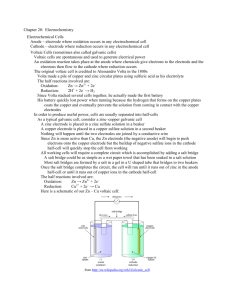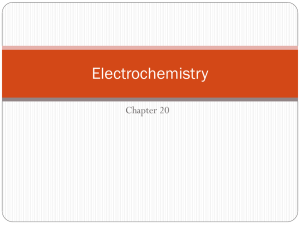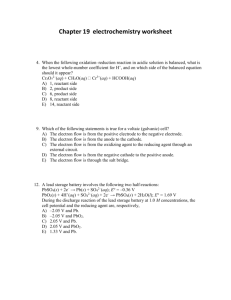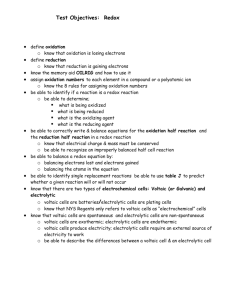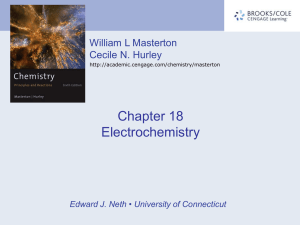Electrochemical Cells - Virtual Lab
advertisement
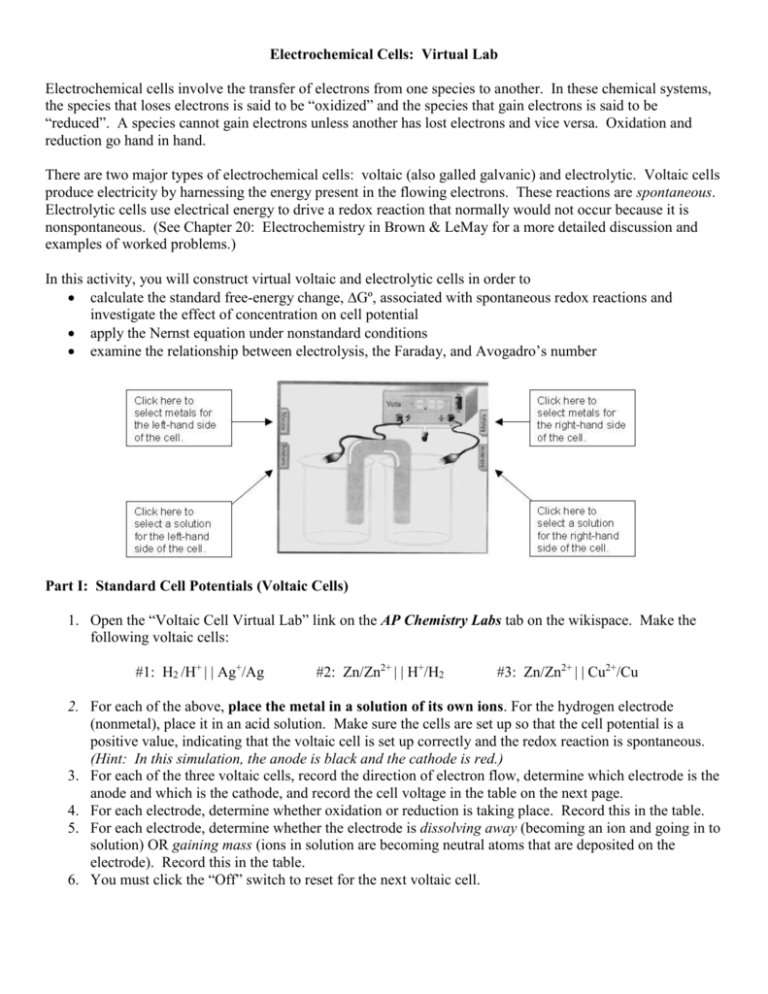
Electrochemical Cells: Virtual Lab Electrochemical cells involve the transfer of electrons from one species to another. In these chemical systems, the species that loses electrons is said to be “oxidized” and the species that gain electrons is said to be “reduced”. A species cannot gain electrons unless another has lost electrons and vice versa. Oxidation and reduction go hand in hand. There are two major types of electrochemical cells: voltaic (also galled galvanic) and electrolytic. Voltaic cells produce electricity by harnessing the energy present in the flowing electrons. These reactions are spontaneous. Electrolytic cells use electrical energy to drive a redox reaction that normally would not occur because it is nonspontaneous. (See Chapter 20: Electrochemistry in Brown & LeMay for a more detailed discussion and examples of worked problems.) In this activity, you will construct virtual voltaic and electrolytic cells in order to calculate the standard free-energy change, ∆Gº, associated with spontaneous redox reactions and investigate the effect of concentration on cell potential apply the Nernst equation under nonstandard conditions examine the relationship between electrolysis, the Faraday, and Avogadro’s number Part I: Standard Cell Potentials (Voltaic Cells) 1. Open the “Voltaic Cell Virtual Lab” link on the AP Chemistry Labs tab on the wikispace. Make the following voltaic cells: #1: H2 /H+ | | Ag+/Ag #2: Zn/Zn2+ | | H+/H2 #3: Zn/Zn2+ | | Cu2+/Cu 2. For each of the above, place the metal in a solution of its own ions. For the hydrogen electrode (nonmetal), place it in an acid solution. Make sure the cells are set up so that the cell potential is a positive value, indicating that the voltaic cell is set up correctly and the redox reaction is spontaneous. (Hint: In this simulation, the anode is black and the cathode is red.) 3. For each of the three voltaic cells, record the direction of electron flow, determine which electrode is the anode and which is the cathode, and record the cell voltage in the table on the next page. 4. For each electrode, determine whether oxidation or reduction is taking place. Record this in the table. 5. For each electrode, determine whether the electrode is dissolving away (becoming an ion and going in to solution) OR gaining mass (ions in solution are becoming neutral atoms that are deposited on the electrode). Record this in the table. 6. You must click the “Off” switch to reset for the next voltaic cell. Part I Data Table Voltaic Electrodes Cell # Ag and H2 Direction of electron flow (“from H2 to Au”) Anode Cathode Eºcell (Volts) Oxidation or Reduction? 1 Dissolving into solution or Gaining mass? Zn and H2 Oxidation or Reduction? 2 Dissolving into solution or Gaining mass? Cu and Zn 3 Oxidation or Reduction? Dissolving into solution or Gaining mass? Analysis Questions: Part I (show setups for any calculations) 1. What is another name for a voltaic cell? 2. For EACH voltaic cell, (#1 – #3): (a) Write the oxidation AND reduction half-reactions. Label each as “oxidation” or “reduction”. (b) Write the balanced, net ionic equation for the reaction. (c) Identify the oxidizing and reducing agents. (d) Calculate the standard free-energy change, ∆Gº, to 3 significant figures, using the equation ∆Gº = –nFEº 3. What is the relationship between voltage, free-energy change, and spontaneity? 4. Write the reaction quotient, Q, for the Zn-Cu cell. 5. Calculate the cell voltage, Ecell, in a Zn-Cu cell if the [Zn2+] is decreased to 0.1 M. Use the Nernst equation. 6. Calculate the cell voltage, Ecell, in a Zn-Cu cell if the [Cu2+] is decreased to 0.1 M. Use the Nernst equation. 7. Compare the cell voltages calculated in Questions 5 and 6 to the cell potential for a Zn-Cu cell under standard conditions. (a) Describe the relationship between the relative concentrations of reactants and products and the cell voltages (i.e., what happens to the cell voltage when you decrease the reactant concentration? What happens when you decrease the product concentration?) Part II: Concentration Cells (Voltaic Cells) 1. Open the “Concentration Cell Virtual Lab” link on the AP Chemistry Labs tab on the wikispace. 2. Make each of the following three Zinc concentration cells by placing solid zinc electrodes into each half-cell and 1.0 M solutions of Zn2+ opposite of the following concentrations. Remember that the voltage should be positive – you may need to switch the electrodes if it is negative. #4: 0.1 M Zn2+ #5: 0.01 M Zn2+ #6: 0.001 M Zn2+ 3. Record the cell voltages in the data table below, along with which half-cell undergoes oxidation (the dilute or concentrated solution), which undergoes reduction (the dilute or concentrated solution), and which half-cells lose and gain mass. Look at the “Molecular Level Reaction” to help visualize these processes. Part II Data Table Cell Half-Cell # Concentrations 4 Direction of electron flow (“from x M to y M”) Oxidation Half-Cell (dilute or concentrated solution) Reduction Half-Cell (dilute or concentrated solution) Ecell (Volts) 1 M and 0.1 M Dissolving into solution or Gaining mass? 1 M and 0.01 M 5 6 Dissolving into solution or Gaining mass? 1 M and 0.001 M Dissolving into solution or Gaining mass? Analysis Questions: Part II (show setups for any calculations) 8. Define “concentration cell”. 9. Write a general balanced, net ionic equation for the reactions – use “Zn2+ (aq) dilute” and “Zn2+ (aq) concentrated” designations in your net equation. 10. Write the reaction quotient, Q, for each zinc concentration cell you constructed (#4 - #6). 11. What is the relationship between the difference in concentration of the half-cells and the cell potential? (i.e., which produces a larger voltage, half-cells with a large or small difference in concentration?) Part III: Electroplating (Electrolytic Cells) 1. Open the “Electrolysis Virtual Lab” link on the AP Chemistry Labs tab on the wikispace. 2. Construct a copper electroplating cell by placing a copper anode and iron cathode in a solution of Cu2+ ions. 3. Record the initial mass of the iron cathode in the data table. 4. Run the simulation at a current of 2.00 amperes at 2.00 V for 5:00 minutes. Record the final mass of the iron cathode. Record in the data table and calculate the mass of copper deposited on the iron. Initial mass of Fe (g) Final mass of Fe (g) Mass of Cu deposited on Fe (g) Analysis Questions: Part III (show setups for any calculations) 12. Calculate the mass of copper that is expected to be deposited on the iron electrode under your experimental conditions. To do this: (a) Determine the number of moles of electrons that were forced to move from the copper electrode to the iron electrode in 5.00 minutes at a current of 2.00 amperes. (b) Determine the number of moles of Cu2+ ions reduced and at the cathode. (c) Convert moles of reduced copper to grams using the gram-formula mass of copper. 13. Calculate the expected amount of Ni deposited on a zinc electrode under conditions of 2.00 V and a current of 5.00 amperes for 15.00 minutes. Show your work. Run the simulation to check your answer. CONCLUSION QUESTIONS 14. Which process ALWAYS occurs at the anode (oxidation or reduction)? Describe this process. 15. Which process ALWAYS occurs at the cathode (oxidation or reduction)? Describe this process. 16. Which electrode ALWAYS loses mass (anode or cathode)? EXPLAIN WHY THIS HAPPENS. 17. Which electrode ALWAYS gains mass (anode or cathode)? EXPLAIN WHY THIS HAPPENS. 18. What are the differences between voltaic cells and electrolytic cells?




